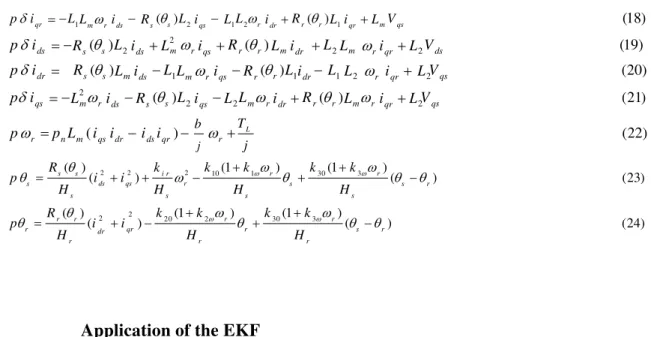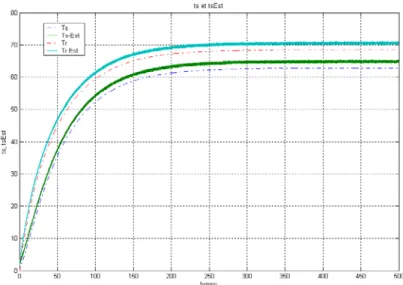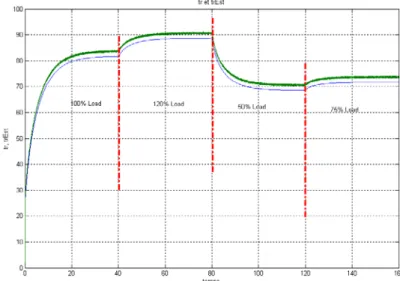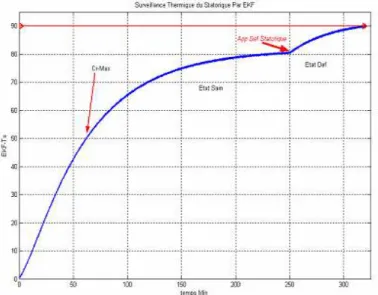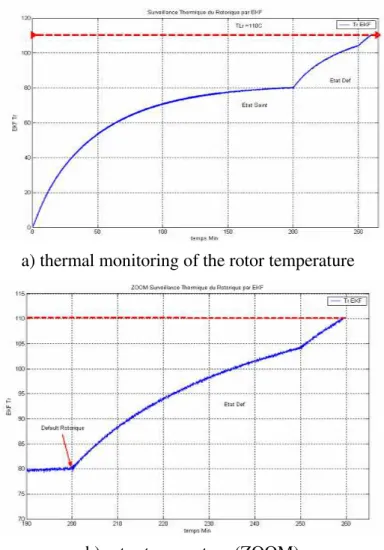Stochastic Estimation Methods for Induction Motor Transient Thermal
Monitoring Under Non Linear Condition
Mellah HACEN1*, Hemsas KAMEL EDDINE2
1
Department of Electrical Engineering, Faculty of Engineering, University Ferhat Abbas of Setif Cité Maabouda, Route de Béjaia / 19000 / Algeria.
2
Automatic Laboratory of Setif, Electrical Engineering Department, University of Setif, Algeria.
E-mail*: has.mel@gmail.com*.
*
Corresponding author: (213) 05 53 03 87 39; Fax: (213) 0 36 83 97 84
Abstract
The induction machine, because of its robustness and low-cost, is commonly
used in the industry. Nevertheless, as every type of electrical machine, this
machine suffers of some limitations. The most important one is the working
temperature which is the dimensioning parameter for the definition of the
nominal working point and the machine lifetime. Due to a strong demand
concerning thermal monitoring methods appeared in the industry sector. In
this context, the adding of temperature sensors is not acceptable and the
studied methods tend to use sensorless approaches such as observators or
parameters estimators like the extended Kalman Filter (EKF). Then the
important criteria are reliability, computational cost ad real time
implementation.¶
Keywords
Induction Motor; Thermal Modelling; Estimation Techniques; Thermal
Introduction
The energy conversion in an electrical machine is inevitably accompanied by losses of
power which emerge in calorific form in the credits part is constrictive machine.
When stator winding insulation materials are heated beyond their temperature limits
by excessive heat from motor losses, the winding insulation materials may experience
accelerated and irreversible deterioration, resulting in reduced motor life or even total motor
failure [1].
To prevent such excessive thermal stress and ensure continuous and reliable motor
operation, the National Electrical Manufacturers Association (NEMA) has established
permissible temperature limits for stator windings of induction machines based on their
insulation classes [2].
It is commonly assumed that the motor’s life is reduced by 50% for every 10°C
increase above its stator winding temperature limit. Therefore, an accurate estimate of the
stator winding temperature is crucial in ensuring proper motor operation below its thermal
limit. Aside from direct stator winding temperature measurement by means of a thermocouple
or resistive temperature detector (RTD), the thermal model based and the induction machine
parameter-based temperature estimators are two major techniques used in tracking the stator
winding temperature [1].
Thermal Modeling Methods of EM
In literature specialized one can gathered the methods of thermal modeling of the
machines electric under the three types following:
Simple Modeling for a Coarse Approach
One finds in the literature of many simple approaches in order to give bonds between
the temperature to the stator and the temperature with the rotor. [3], [4] thus present an
identification method of the rotor of electric resistance which does not make it possible
unfortunately to consider stator electric resistance These articles propose two thermal
approaches then to bind two resistances of the electric model:
has a temperature higher of 10C than that of the stator.
2 The second method, based on work of Kubota, gives a simple relation of
proportionality between two resistances calibrated on the face values of the maker badge. One
finds the method of the proportionality in other articles like [5].On the other hand, of later
work were realized on model EDF and put a flat as for its validity for all the operating modes
[6].
Fine Modeling for a Precise Thermal Cartography
It is based on the use of the finite element method with a model geometric and
mechanics detailed.
Figure 1. Thermal cartography portion of an asynchronous machine, obtained by finite elements [9]
This makes it possible to obtain a complete cartography of the temperature of the
machine (Figure.1). These results are very interesting since they make it possible to give an
idea of the places where the temperature becomes critical according to the operations and
answer the problems of the hot points [7, 8].
Electrical Equivalent Supply Networks (Nodal Method) [10] [11]
Those generally model the whole of the machine with nodes of temperature associated
with each material used [12]. The identification of this model is thus carried out either by
finite elements, or by a great number of points of temperature measurement within the
machine. These models are generally very detailed (Figure 2) and thus too complex for our
Figure 2. Equivalent thermal models of the asynchronous machine [12]
As our goal principal is the use of kalman filter, these two types of models are not
exploitable, because these methods do not give the formalism of state.
Simplified Models
Other researchers sought to simplify the models by gathering the losses in subsets and
by approximating the temperature in an unspecified point by a simple exponential answer
which one can simply represent by a resistance and a heat capacity [13] and [14].
Figure 3. Thermal model of the asynchronous machine [13]
Thermal Modelling of IM
In many cases the model is the familiar steady-state equivalent circuit, but for high
performance drives a full transient model of the motor is required. Effective modeling, and
therefore the effectiveness of drive control and estimation, is limited by the complexity of the
circuit, nonlinearity of the magnetic circuit, and temperature dependence of the stator and
rotor electrical circuits all impact on the accuracy with which the motor can be modeled [15].
The modeling of the IM taking all the real behaviors without Assumptions simplifying being
very difficult or impossible. For that one will suppose a model with simplifying assumptions.
This paper addresses the third of these effects (temperature dependence) by incorporating a
thermal model of the motor in the estimation process. The frequency dependence of the rotor
electrical circuit and nonlinearity of the magnetic circuit are not included.
Temperature estimation in the induction motor has been dealt with by many authors
see [11], but most of these publications describe either a very complex lumped-parameter
network or the finite-element method.
A state-variable model of the induction motor is required for the EKF algorithm. The
twin-axis stator reference frame [15] is used to model the motor’s electrical behaviour,
because physical measurements are Made in this reference frame; the well-known linear
relationship between resistance and temperature must be taken into account for the
stator and rotor resistances
0
0
( ) (1 )
( ) (1 ) (1)
s s s s s
r r r r r
R R
R R
θ α θ
θ α θ
= +
= +
Or: Rs0, Rr0 stator and rotor resistance at the ambient temperature, αs and αr them
coefficients thermal respectively. In the IM traditional models, one replace R1 and R2 by
( S)
Rs θ and Rr(θr) respectively, what can be rearranged in space of state on the format:
1 2 1 2 1
2
2 2 2
1 1 1 2 2
2
2
( ) ( ) (2)
( ) ( ) (3)
( ) ( ) (4)
( )
qr m r ds s s qs r dr r r qr m qs
m m m
ds s s ds r qs r r dr r qr ds
dr s s m ds m r qs r r dr r qr qs
qs m r ds s s
p i LL i R L i LL i R L i L V
p i R L i L i R L i L L i L V
p i R L i L L i R Li L L i LV
p i L i R L i
δ ω θ ω θ
δ θ ω θ ω
δ θ ω θ ω
δ ω θ
− − − = + + − = + + + + − − − = + − −
= qs −L2Lmωridr+Rr(θr)Lmωr iqr +L2Vqs (5)
2 1 2
Where :δ =L L −Lm
The mechanical behaviour can be modeled by:
(6)
r r L
T =bω + j pω +T
But the electromagnetic torque of the motor T can be represented in term of stator and
rotor current components:
(7)
( )
n m qs dr ds qr
T =p L i i −i i
of state is:
( ) L (8)
r n m qs dr ds qr r
j
T b
j pω =p L i i − i i − ω +
The thermal model is derived by considering the power dissipation, heat transfer and
rate of temperature rise in the stator and rotor. The stator power losses include contributions
from copper losses and frequency - dependent iron losses [15].
( ) ( ) (9)
s qs dr ds qr s s ir r p L = i i −i i R θ +k ω
Or: Kir is it constant of iron loss.
The rotor power losses are dominated by the copper loss contribution if the
motor is operated at a low value of slip so:
2 2
( ) ( ) (10)
qr
dr
r r r
p L = i −i R θ
Or: Hs, Hr are the stator and the rotor heat capacity respectively.
A simple representation of the assumed heat flow is given in Figure. 1. Heat
flow from the rotor is either directly to the cooling air with heat transfer coefficient k2,
or across the airgap to the stator with heat transfer coefficient k3
2 r r r 3( r s) (11)
r k H p k
p L = θ + θ + θ −θ
Heat flow from the stator is directly to the cooling air ,with heat transfer coefficient k1
1 s s s 3( r s) (12)
s k H p k
p L = θ + θ − θ −θ
For an induction motor with a shaft mounted cooling fan, the heat transfer coefficients
are dependent on the rotor speed. This dependence has been modeled approximately by a set
of linear relationships
1 10 1
2 20 2
3 30 3
(13 ) (14 ) (15 )
(1
)
(1
)
(1
)
r r rk
k
k
k
k
k
k
k
k
ω ω ω
ω
ω
ω
= = =+
+
+
Or: k10, k20 and k30 thermal power transfer coefficients at the zero speed. k1w, k2w and
k3w variation of thermal power transfer with speed.
Substitution into equations15 and 16 in the equations 13,14,17,18 and 19, and
rearranging yields the thermal state equations for the stator and for the rotor:
2 2 2 10 1 30 3
( ) (1 ) (1 )
( ds qs) r ( ) (16)
s s i r r r
s s s r
s s s s
R k k k k k
p i i
H H H H
ω ω
θ ω ω
2
2 20 2 30 3
(17)
(1 ) (1 )
( )
( qr) ( )
dr
r r
r r
r r s r
r r r
k k k k
R
p i i
H H H
ωω ωω
θ
θ = + − + θ + + θ θ−
The whole of preceding equations (6) a (9), (12), (20), and (21) gives us the model of
following state:
1 2 1 2 1
2
2 2 2
1 1 1 2 2
2
( ) ( ) (18)
( ) ( ) (19)
( ) ( ) (20)
( )
qr m r ds s s qs r dr r r qr m qs
m m m
ds s s ds r qs r r dr r qr ds dr s s m ds m r qs r r dr r qr qs qs m r ds s s
p i LL i R L i LL i R L i L V
p i R L i L i R L i L L i L V
p i R L i LL i R Li L L i LV
p i L i R
δ ω θ ω θ
δ θ ω θ ω
δ θ ω θ ω
δ ω θ
− − − = + + − = + + + + − − − = + − − =
2 2 2 10 1 30 3
2
2 20 2 30 3
2 2 2
( ) (1 ) (1 )
( ) ( ) (23)
(1 ) (1
( )
( )
( ) (21)
( ) (22)
ds qs r
L
s s i r r r
s s s r
s s s s
r r r
r dr qr r
r r
m r r r m r qs
qs dr qr
r n m qs dr ds qr r
j
T b
j
R k k k k k
p i i
H H H H
k k k k
R
p i i
H H
L i L L i R L i LV
p p L i i i i
ω ω
ω ω
θ ω ω
θ ω θ θ θ
ω θ
θ θ
ω θ ω
ω ω + + = + + − + − + + = + − + − + + = − − + )
( ) (24)
r s r r
H
ω θ −θ
Application of the EKF
A reconstructor of state or estimator is a system having like entry, the entries and the
exits of the real process, and whose exit is an estimate of the state of this process. The
extended Kalman filter algorithm takes account of process and measurement noise in a
general nonlinear system:
( ) ( ) ( ) ( )
( ) ( ) ( )
1
(25)
k k k k
k k k
x A x Bu w
y Cx v
+ = + +
= +
⎧
⎨
⎩
Figure 4. Application of EKF in IM
When: w(k) v(k) represents the process and measurement noise respectively. A. The prediction stage is:
Err_KE_MAS
( ) ( ) ( )
( )
1 (26)
( 1) ( ) (27)
ˆ (ˆ , )
T
k
k k
P k F k P k F Q
x + f x u
+ = +
=
B. The correction stage is:
(
)
(
)
(
(
)
)
(
)
( ) ( ) ( )
{
( ) ( )}
1
1/ 1 1 1 1
1 1 1 (28)
1 1 1 1 (29)
ˆ ˆ ˆ (30)
( ) ( ) ( )
T T
k k k k k k
K k P k C CP k C R
k k k k k
x x K y C x
P P K CP
− + + + + + + = + + + + + + + = + − = +
C. Covariance matrices initial Values
The matrix of covariance of error in estimation P and square of 7×7, translated the
confidence which we can have in the adopted model, It is given [15] by:
(0) diag [ 5 5 5 5 2 1 1]
p =
The matrix of covariance of the noise of state Q quantifies the precision of the model
and allows the dynamic adjustment of the parameters. It is generally difficult to determine
because the direct observation of the state of the system is impossible, it is given in [15] by:
0 0
5 4
[1.2 1.2 0.3 0.01 10 10 ] )
(
Q =diag − −
The matrix of covariance of noise of measurement R translated the level of noise to
the measure it is given in [15] by:
0 0
1 0
0.22
0 1
R = ⎡⎢ ⎤⎥
⎣ ⎦
Simulation Result
Constant Load
The two temperatures (thermal model and estimation) vary at different rates, Because
of the differences in the losses, thermal capacities and the power transfer coefficients between
the stator and rotor.
The stator and rotor temperature in the established mode reached the value 65°C, 72°C
respectively but their value considered reached 62.3°C and 69.6°C.
Figure, 5 shows that deference between the rotor and the stator temperature is ≈10 C0 verified EDF experiment (The EDF experiment which considers that the rotor has a
Figure 5. The estimation and thermal model temperature of stator and Rotor result under the constant load condition
Variable Load
In order to verify the model performance for variable load, some step variations of
load are applied (100% → 120% →50% → 75% of the rated load).
Figure 6. Stator temperature simulation result under the variable load condition
temperature of stator and rotor winding under the variable load condition, the deference
between the thermal model temperature and EKF is ≈2.4°C and ≈2.7°C for the stator and the
rotor respectively.
Figure 7. Rotor temperature simulation result under the variable load condition
Thermal Monitoring Based Model for Prevention of Heat Damage of Electric Motors
Basic assistance of this technique is the reference [16] where it is monitoring an
internal temperature, but D. Staton [14] shows that the temperature distribution is not uniform
and also the temperature more critical and restrictive and that of the windings. Our
contribution is to exploit the help of Y. Huai [17] in the model presented in [15].
Figure 8. Diagram of simulation used to monitor the operation of the motor
We need to determine how long the engine can operate in the given condition without
program in Matlab / Simulink, which uses our thermal model. In Figure 8 we show a
schematic diagram of simulation used to monitor the operation of the motor.
a) thermal monitoring of the stator temperature
b- stator temperature (ZOOM)
Figure 9. Thermal monitoring of the stator temperature
One applies torque intense and a stator defect to increase the stator temperature at
limiting temperature TLS before the rotor temperature reaches the limit TLR (Figure. 9).
Under these conditions indicated above, the temperature in the stator winding
temperature limit hit stator (TLS = 90°C) after 68min of engine operation (Figure. 9).
Figure 10 shows that we have applied a couple intense and a rotor failure at t =
200min to increase the rotor temperature to LRT, and we see that the temperature in the rotor
a) thermal monitoring of the rotor temperature
b) rotor temperature (ZOOM)
Figure 10. Thermal monitoring of the rotor temperature
In both cases additional (TS = TLS or TR = TLR) and the engine will trigger the thermal
protection of the windings is checked, so we will increase the life of the motor windings. This
means that the engine should be operational for less than one 68 min to avoid overheating the
stator and less than 58 minutes to the rotor.
Conclusion
Since the sensors can be not very reliable or expensive, the use of an estimator
becomes necessary. The filter of Kalman makes it possible to achieve this goal, because it
enables us to estimate and predict, simultaneously the temperature stator and rotor starting
from the knowledge of the currents of food of various windings, which is well shown through
calculation with simplified thermal model proposed in this paper is feasible. The error
between the simplified thermal model proposed in this paper and the recent publications is
acceptable. The simplified thermal model can be used to estimate both steady state and
transient state temperature of key positions in high-speed generator. The overload running
time calculation problem can be solved under the hot condition overload and cold condition
overload. The simplified thermal model is also adapted to the various types of generator and
motor, but modeling for different type generators and motor and calculating its model
parameters are a hard work.
The use of EKF can not only estimate the stator and rotor temperatures but also allows
us to perform a preventive monitoring technique based on the use of Matlab / Simulink, acting
on the control of the power source.
The advantage of the thermal monitoring of IM and increased the life of insulation is
therefore asynchronous.
References
1. Gao Z., Habetler T.G., Harley R.G., Colby R.S., An Adaptive Kalman Filtering Approach to Induction Machine Stator Winding Temperature Estimation Based on a Hybrid Thermal Model, IEEE, 2005.
2. Information Guide for General Purpose Industrial AC Small and Medium Squirrel-Cage
Induction Motor Standards, NEMA Standard MG1-2003, Aug. 2003.
3. Beguenane R., El Hachemi Benbouzid M., Induction motors thermal monitoring by means of rotor resistance identification, Electric Machines and Drives Conference Record, 1997, p. TD2/4.1 - TD2/4.3.
4. Beguenane R., Benbouzid M.E.H., Induction motors thermal monitoring by means of
rotor resistance identification, IEEE Transaction on Energy Conversion, 1999, 14(3), p. 566 - 570.
5. Sang-Bin L., Habetler T.G., Harley R.G., Gritter D.J., A stator and rotor resistance estimation technique for conductor temperature monitoring, Industry Applications Conference, 2000, Conference Record of the 2000 IEEE, 2000, 1, p. 381-387.
6. Saïd M.S.N., Benbouzid M.E.H., H–G Diagram Based Rotor Parameters Identification
for Induction Motors Thermal Monitoring, IEEE Transactions on Energy Conversion, 2000, 15(1), 14-18.
IEEE, 2008.
8. Sarkar D., Mukherjee P.K., Sen S.K., Use of 3-dimensional finite elements for
computation of temperature distribution in the stator of an induction motor, Electric Power Applications, IEE Proceedings B, 1991, 138(2), p. 75-86.
9. Chauveau E., Contribution au calcul électromagnétique et thermique des machines
électriques – Application à l’étude de l’influence des harmoniques sur l’échauffement des moteurs asynchrones, Thèse de doctorat de l’Université de Nantes, 2001.
10.Boglietti A., Cavagnino A., Staton D., Shanel M., Mueller M., Mejuto C., Evolution and Modern Approaches for Thermal Analysis of Electrical Machines, IEEE Transactions on Industrial Electronics, 2009, 56(3), p. 871-882.
11.Okoro O.I., Dynamic and thermal modelling of induction machines with non linear
effects, Kassel University Press GmbH, Kassel, 2002, ISBN 3-89958-003-6.
12.Lazarevic Z., Radosavljevic R., Osmokrovic P., A novel approach for temperature
estimation in squirrel-cage induction motor without sensors, IEEE Transactions on Instrumentation and Measurement, 1999, 48(3), p. 753-757.
13.Hurst K.D., Habetler T.G., A thermal monitoring and parameter tuning scheme for
induction machines, Industry Applications Conference, 1997, Thirty-Second IAS Annual Meeting, IAS '97, Conference Record of the 1997 IEEE, 1997, 1, p. 136-142.
14.Moreno J.F., Hidalgo F.P., Martinez M.D., Realisation of tests to determine the
parameters of the thermal model of an induction machine, Electric Power Applications, IEE Proceedings, 2001, 148(5), p. 393-397.
15.Al-Tayie J.K., Acarnley P.P., Estimation of speed, stator temperature and rotor
temperature in cage induction motor drive using the extended Kalman filter algorithm, Electric Power Applications, IEE Proceedings, 1997, 144(5), p. 301-309.
16.Huai Y., Melnik R.V.N., Thogersen P.B., Computational analysis of temperature rise phenomena in electric induction motors, Applied Thermal Engineering, 2003, 23, p. 779-795.
17.Staton D., Hawkins D., Popescu M., Thermal Behaviour of Electrical Motors – An
Analytical Approach, CWIEME 2009 Paper MDL [online] Available at:
![Figure 1. Thermal cartography portion of an asynchronous machine, obtained by finite elements [9]](https://thumb-eu.123doks.com/thumbv2/123dok_br/18360858.354139/3.892.271.626.468.694/figure-thermal-cartography-portion-asynchronous-machine-obtained-elements.webp)
![Figure 2. Equivalent thermal models of the asynchronous machine [12]](https://thumb-eu.123doks.com/thumbv2/123dok_br/18360858.354139/4.892.273.611.131.380/figure-equivalent-thermal-models-asynchronous-machine.webp)
